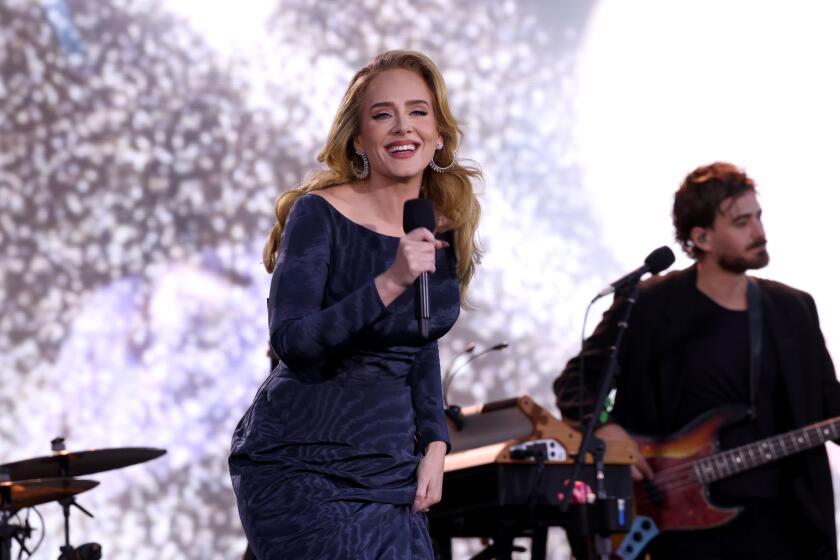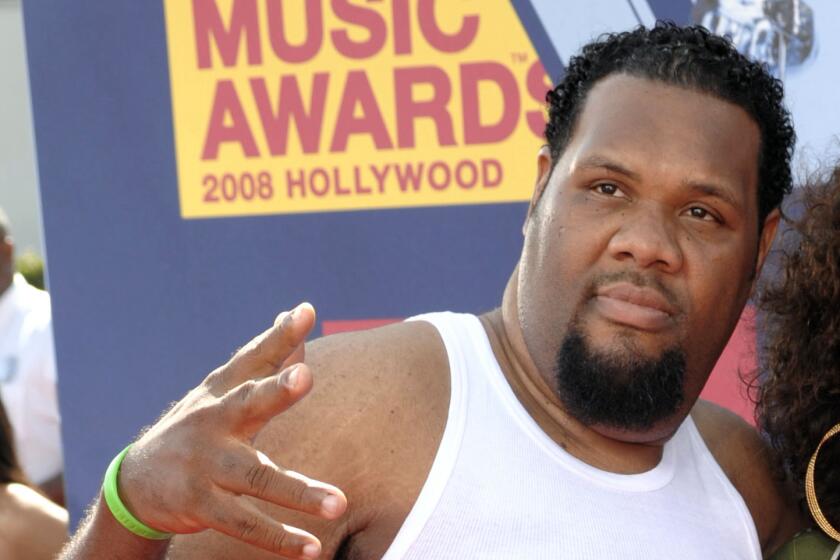Peggy Lee Did Do Right by Her Material
It’s hard to believe it’s been more than 15 years since I visited Peggy Lee in her hilly Bel-Air estate. Searching for an update on a legendary artist whose widespread public visibility was beginning to diminish, I spent an intriguing afternoon with a woman who, then in her mid-60s, was plagued by heart problems (she had double bypass surgery in 1985) and a variety of serious health concerns.
Yet her skin seemed as milky clear as it did in the clips from the film “Pete Kelly’s Blues” and, earlier, in the black-and-white videos of her performances with the Benny Goodman band. She looked more slender than she had in years, showing no signs of the physical problems that had plagued her for most of her adult life.
Above all, Lee’s voice still resonated with the throaty sensuality that made her recordings so instantly recognizable.
Despite her open willingness to speak freely about almost any area of her complex life story, however, there was a diva-like reserve about Lee, an invisible but palpable aura clearly defining and protecting the inner fires that kept her star power burning. It wasn’t a “Sunset Boulevard” experience by any means, but there was never any doubt that I was in the presence of someone with a clear understanding of her magnitude in the entertainment firmament.
I’d seen Lee several times before that, reviewing her at Manhattan’s Cafe Rouge for the New York Times in the ‘70s and later, in the mid-’90s, at the Hollywood Bowl for the Los Angeles Times. But I did not experience her--other than via her recordings--during the years with Goodman or the ‘50s successes with “Black Coffee,” “Fever” and “Lover.” Still, given the reference points I had, I left that mid-’80s conversation with the distinct feeling that Lee still possessed all the fundamental physical capacity to continue singing at her usual high creative level.
But I also was vexed by something far less apparent. A sense that some drive, some inner urge was missing. A sense that the many illnesses, some chronic, some the result of frightening accidents (she experienced a near-fatal fall in 1976 in New York and another in Las Vegas in the ‘80s); the failure of her Broadway musical, “Peg,” in 1983 after only 18 performances; her four failed marriages; had all combined to create a cumulative weight difficult for anyone to carry. And an especially troublesome burden to sustain while trying to find new inspiration in the hit songs that her public wanted to hear, over and over again.
As it turned out, the ambivalence of my reaction to Lee was affirmed over the next few years. Performances in the late ‘80s and beyond--even when she was obliged to take the stage in a wheelchair--revealed that much of the Lee magic remained intact. But her health problems increased into the ‘90s, including a debilitating stroke in 1998. She died Monday night at her home in Bel-Air. She was 81.
In retrospect, the mid-’80s seemed to be her turning point, the time when the balance between her capacity to perform at peak level and the impairments of her physical problems began to shift toward the latter. In the 40-plus years before the mid-’80s, however, Lee’s talent was always in the preeminent position, even during the many physical and emotional distractions that plagued her life from the very beginning.
The Diana Krall Connection Is Apt
Most of the obituaries have emphasized the sultry sensuality of her voice. And there’s no denying the irresistible appeal of her sound. But too little attention was devoted to three other significant aspects of her art: the quality of her phrasing; her capacity to pinpoint the emotional center of a song; and her subtle sense of swing.
Diana Krall has often been compared to Lee, with justification. The usual correlation centers on the obvious--that both are knockout blonds with the simmering capacity to entice listeners into the web of their performances. Less mentioned has been the musicality they share, especially in their phrasing. Lee was not the instrumentalist that Krall is. But her intuitiveness, present not only in her sensitive interpretations but also in the phrasing of her many hit song lyrics, was the product of a similarly inventive imagination.
Lee and Krall are also similar in the sense that both place the verbal accuracy of their phrasing front and center, resisting, as so many singers fail to do, the temptation to distort the meaning of line in order to hold an attractive note.
Finding the story at the heart of a song has not always been a common attribute among jazz singers--even among some of the finest jazz singers. And it took a while before Lee gathered sufficient life experience to lead her fully into the depths of interpretation. But once she did, the results were extraordinary. A few of the many examples: the dark intensity of “Don’t Smoke in Bed”; the soaring, rhythmic passion of “Lover”; the world-weary ennui of “Is That All There Is?”
Regarding her sense of swing, some observers have been loath to even categorize Lee as a jazz singer, preferring to describe her as someone who performed in jazz settings, or who occasionally phrased with jazz-like emphasis. Obviously, the great diversity of her career, combined with her own creative eclecticism, led her through virtually every aspect of popular music, from big bands to small groups, from pop songs to jazz ballads, from television variety shows to songwriting for films. Much of it didn’t call for anything relating to jazz. But when it did, Lee was ready.
As early as the ‘40s, her rendering of “Why Don’t You Do Right” with the Benny Goodman band flowed with an easygoing, confident sense of rhythm. On novelty tunes such as “Fever” and “Manana,” Lee transformed relatively simple lines and phrases into jaunty, upbeat rhythmic excursions, and did so without losing either the sensuality or the humor of the words.
When she was working in jazz settings--occasional outings with big bands, a concert recording with George Shearing--her brightly swinging style, skimming easily across the surface of the rhythm, was in full blossom.
The most accurate comparison point for Lee, in fact, may be the similarly diverse career of Frank Sinatra. Both started out in the big-band era, emerged as solo stylists, did film work (Sinatra vastly more than Lee) and were firmly linked--in style, substance and manner--to the jazz world. Like Sinatra, Lee may never fully receive the acknowledgement she deserves as a jazz artist. But, in both cases, the evidence remains in their recordings, testimony to talent that circled the entire pop music world without ever losing its essential connection with its jazz roots.
More to Read
The biggest entertainment stories
Get our big stories about Hollywood, film, television, music, arts, culture and more right in your inbox as soon as they publish.
You may occasionally receive promotional content from the Los Angeles Times.










